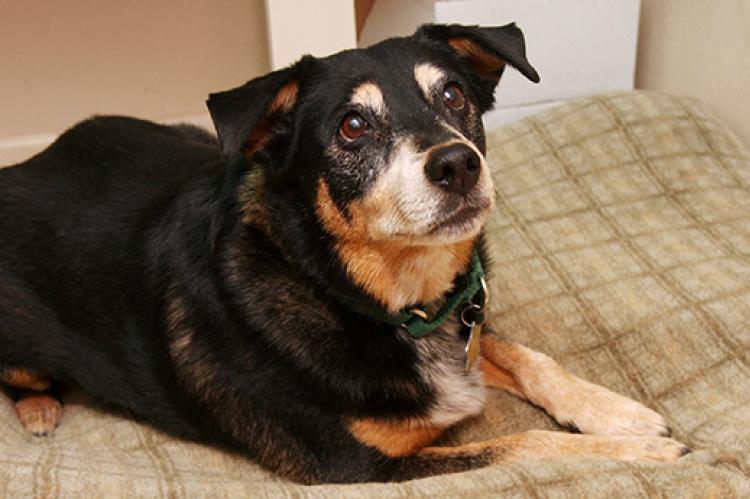How to Teach a Dog 'Go to Your Place'

Teaching a dog to go to a specific place can be helpful when you need your dog to settle down or stay in a particular spot for a while. Your dog can be out of the way but also in a comfortable and safe area. This is a great dog training cue to use when someone comes to the door, you are making dinner, or you just need to not have your dog underfoot.
Steps to teach a dog to go to their place
The result of training the "go to your place” cue is the dog will go to their bed or other predetermined spot and settle there in a sit or down position until you give a release cue. The dog should already be trained in “sit” or “down” prior to practicing this cue.
- Get a mat, blanket, dog bed, or towel, and put it on the floor next to you. Make sure it won’t slip when your dog walks on it. Also, gather some high-value treats.
- Stand next to the mat neutral with your arms by your side and staring at the mat (or whatever object you’ve chosen). As soon as your dog steps onto the mat, click a clicker or say your marker word (e.g., “yes”) and then toss a treat away from the mat. We want to encourage the dog to come back to the mat without luring them back. Having your dog problem-solve what you are asking will help solidify the behavior.
- Not all dogs will get onto their place and sit or lie down right away. If your dog will only go near the mat or put a foot on at a time, you’ll work in approximations. Start by marking (clicking or saying your word) and rewarding the dog looking at the mat if that’s where they are starting and then working up to them getting closer to touching the mat. Eventually they will immediately move to the mat when you begin the exercise.
- Decide the final picture: Do you want the dog to sit on the mat or lie down? You might have to cue them either to sit or lie down once they are consistently going on the mat. But once they are performing that you can add your verbal cue; you can choose “place,” “mat,” “bed,” or whatever works well.
- After the dog is consistently going to the mat and sitting or lying down, it’s time to work on distance and duration. Cue them to "place," take a step back, and then mark and reward. Continue to do this until you can take two steps back, three steps, etc. But make sure you aren’t waiting so long that your dog frequently pops off of the place.
- You’ll also want to practice cueing “place” from a distance. Begin by taking a step away from the place and cueing — then two steps, three steps, etc.
- Once your dog is consistently sitting/lying on the mat until you release them, you can work on specific scenarios. For example, if you want your dog to go to the place when someone knocks or the doorbell rings, get a friend to ring the doorbell but not enter — or play a doorbell sound on your phone. Then you can cue the dog to the place.
- Continue to practice that by having the friend ring the bell and then enter the house, sit down, spend some time, etc. Eventually the dog will begin to automatically walk to their place when they hear the doorbell or a knock.
Proofing the 'go to your place' cue
Proofing in dog training means teaching the dog to generalize the cue in different contexts — in different areas, with different distractions and handlers, and for longer periods of time.
Gradually increase the amount of time your dog stays on their place from 10 seconds to 15, 30, 45, and a minute. Once your dog can stay on the mat for a full minute, you can start working on distractions.
Here are some distractions you can introduce:
- Squeaky toys
- Other dogs
- You moving around
- Another person moving around
- A familiar person entering the house after the doorbell rings
- An unfamiliar person entering the house after the doorbell rings
In addition to distractions, you also should work on distance. Ask your dog to go to their place when they’re at different distances from the place — e.g., a foot away from their mat, 3 feet from it, across the room from it, etc.
Likewise, you should practice being at different distances from your dog. After asking your dog to go to their place, move a couple steps away, then several feet away, and then all the way across the room. You can also assume different positions. Try asking them to go to their place when you’re sitting, with your back slightly turned from your dog, and any other position you can think of.
Additional dog training tips
If your dog is having trouble learning the “place” cue, here are some additional tips to try:
- Don’t forget to give the release cue every time, so your dog learns that they should hold their position.
- If you're using a mat, pick it up whenever you are not actively training until your dog has mastered the cue. If you are using your dog’s bed to train, put a towel or blanket on top of the bed during your training sessions and remove it when you are done.
Don’t rush the process; go at the dog’s speed. Keep training sessions short, and take breaks if your dog isn’t focused. The process should be a fun, relationship-building activity for both you and your dog.